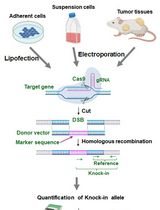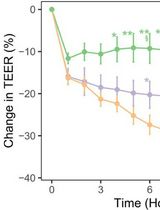- EN - English
- CN - 中文
Bacterial Infection with Listeria monocytogenes in Mice and Subsequent Analysis of Antigen-Specific CD8 T Cell Responses
小鼠李斯特菌感染和抗原特异性 CD8 T 细胞反应的后续分析
发布: 2021年12月05日第11卷第23期 DOI: 10.21769/BioProtoc.4247 浏览次数: 3653
评审: Giusy TornilloAmit Kumar DeyRakesh Bam
Abstract
Pathogens such as bacteria, viruses, fungi, or protozoa can cause acute and chronic infections in their hosts. The intracellular bacterium Listeria monocytogenes serves as a model pathogen to assess the molecular mechanisms regulating CD8 T cell activation, differentiation, and function. We set up an experimental workflow to investigate cell-intrinsic roles of the nuclear receptor NR2F6 in CD8 T cell memory formation upon Listeria monocytogenes (LmOVA) infection (Jakic et al., 2021). The current protocol details how to cultivate ovalbumin-expressing LmOVA, infect naïve C57BL/6 mice with these bacteria and determine the bacterial load in host organs. Furthermore, we describe how to evaluate antigen-specific CD8 T cell responses and discriminate between short-lived effector and memory precursor cells in vivo following LmOVA infection (Figure 1). To assess CD8 T cell-intrinsic molecular mechanisms, we integrated an adoptive cell transfer (ACT) experiment of genetically modified naïve OT-I CD8 T cells into congenic hosts before LmOVA infection.
Graphic abstract:

Figure 1. Experimental workflow depicting the steps for infection of mice with Listeria and subsequent analysis of antigen-specific CD8 memory responses. Bacteria (ovalbumin expressing Listeria monocytogenes) are thawed and grown on lysogeny broth (LB) plates overnight (ON). A single colony is picked and grown in LB medium ON. Bacteria from the exponential growth phase are then injected into a C57BL/6 mouse via tail vein injection. Colony forming units (CFU) of the bacteria can be detected in the spleen on day 3 post injection. Antigen-specific CD8 T cell immune response can be investigated during the acute phase (d3 after infection), during the peak of the adaptive immune response (d7), the clearance phase (d26), or the memory phase (d70) by flow cytometry. Created with BioRender.com.
Background
Listeria monocytogenes (Lm) is a gram-positive facultative intracellular bacterial pathogen that is the causative agent of listeriosis (Hamon et al., 2006; Khan and Badovinac, 2015). Murine listeriosis has served as a well-defined mouse infection model since the 1950s (Osebold and Sawyer, 1957). Both innate and adaptive immune cells are crucial for eliminating these bacteria (Zenewicz and Shen, 2007). Cellular responses to Lm infection are highly reproducible, and bacterial load in the host is easy to quantify. At sub-lethal doses (LD50 dose of LmOVA: ~5 × 106 CFU), Lm induces a robust immune response that is dependent on T cell-dependent bacterial clearance (Zenewicz and Shen, 2007). Thus, in addition to lymphocytic choriomeningitis virus (LCMV) infection, systemic bacterial infection with Lm has been a favored approach for the characterization of pathogen-specific CD8 T cell effector responses and memory formation for more than five decades (Mackaness, 1962; Harty and Bevan, 1995; Shen et al., 1998; Badovinac et al., 2000; Khan and Badovinac, 2015; Qiu et al., 2018; Levine et al., 2021). Lm naturally infects most mammalian hosts via the gastrointestinal tract (Pamer, 2004). However, in contrast to humans, mouse E-cadherin does not allow internalin-dependent entry into gastrointestinal epithelial cells when infected orally (Lecuit et al., 1999). Following intravenous inoculation in mice, Lm is taken up from the bloodstream by splenic and hepatic macrophages, which transport the bacteria to the T-cell zone of lymphatic organs (Merrick et al., 1997; Pamer, 2004).
Inbred mouse strains such as C57BL/6 or BALB/c respond with different MHC class I (CD8) or MHC class II (CD4) epitopes to infection by Lm. Whereas a response to the MHC-II restricted epitope listeriolysin O (LLO)190-201 is mainly observed in C57BL/6 mice, a response to the MHC-I restricted epitopes LLO91-99, and p60217-225 is dominant in BALB/c mice (Pamer et al., 1991 and 1994) (Zenewicz and Shen, 2007). Furthermore, Lm have successfully been engineered to express novel H2-Kb epitopes (Zenewicz and Shen, 2007). Other strains with attenuated pathogenicity allow the use of this bacterium in immuno-compromised mice, and the manipulation of the duration of infection by antibiotics and luminescence reporters have diversified the experimental options (Schmidt et al., 2012). One particularly useful Lm strain has been engineered to express the model antigen ovalbumin (OVA) (Pope et al., 2001; Foulds et al., 2002). This LmOVA strain is compatible with a range of animal models, such as T cell receptor (TCR) transgenic OT-I mice, and powerful immunological tools, such as OVA-tetramers for detecting antigen-specific CD8 T cells. Thus, the LmOVA strain is well suited for the investigation of transcriptional regulation, effector versus memory differentiation fates, or metabolic states of antigen-specific CD8 T cells (Pope et al., 2001; Zenewicz and Shen, 2007; Jakic et al., 2021; Harberts et al., 2021; Levine et al., 2021). Zehn et al. (2009) generated recombinant Lm strains expressing OVA protein-containing native SIINFEKL (N4) or altered OVA, where certain amino acids have been exchanged, and are termed altered peptide ligands (APL), such as A2(SAINFEKL), Y3, Q4, T4, and V4. These latter OVA variants bind H-2Kb as well as N4 but differ in their OT-I stimulation potency.
Memory formation is a hallmark of T cell-mediated immunity. However, the mechanism by which differentiation is adjusted at the molecular level, into either short-lived effector cells (SLECs) or memory precursor CD8 T cells and subsequent regulation of long-term memory, remains incompletely understood (Ahmed and Gray, 1996; Harty and Badovinac, 2008; Kaech and Cui, 2012; Chang et al., 2014; Jakic et al., 2021; Harberts et al., 2021; Levine et al., 2021). Following LmOVA infection, antigen-specific CD8 T cell responses can be investigated in vivo over time; in addition, it is possible to determine long-term persistence and re-infection responses (Jakic et al., 2021).
Here, we provide a methodological setup for LmOVA culture, infection of mice, and analysis of splenic colony-forming units (CFUs). We also describe methods that allow the investigation of blood or spleen-derived antigen-specific short-lived effector (SLECs, CD127−KLRG1+) and memory precursor (MPECs, CD127+KLRG1−) CD8 T cells, via flow cytometric analysis at different time points after LmOVA infection. Functional studies of CD8 T cell responses following antigen-specific peptide stimulation in vitro at various time-points, such as days 1-3 (early activation), day 7 (acute response), day 28 (after contraction), and day 70 (memory) are also described.
The current infection protocol is of use for the analysis of responses from innate and adaptive immune cells. Finally, the protocol is suitable for adoptive cell transfer (ACT) experiments of naïve OT-I CD8 T cells from genetically defined mouse strains into congenic hosts, with or without re-infection in vivo. This option offers the opportunity to precisely define donor CD8 T cell responses independent of a possibly altered microenvironment in germ-line deficient mouse strains.
Materials and Reagents
Listeria monocytogenes expressing ovalbumin, strain DMC 09-082 (LmOVA), carries an erythromycin resistance plasmid (Foulds et al., 2002; Ahn et al., 2016).
Notes:
Pathogen safety caution: Listeria monocytogenes is a facultatively anaerobic, gram-positive, rod-shaped coccobacillus, which causes a mild febrile illness. Disease manifestations include listeriosis in pregnancy, listeriosis of the central nervous system (CNS), febrile gastroenteritis, glandular listeriosis, local listeriosis, typhoid listeriosis, and atypical listeriosis. L. monocytogenes is commonly classified as a bio-safety class 2 organism. When working with L. monocytogenes, personal protection safety measures should be planned ahead and in accordance with official biosafety regulations. Please note that pregnant women are not advised to work with L. monocytogenes, as listeriosis can cause severe disease of the fetus or newborn baby.
All liquids should be discarded into bottles containing 10% sodium hypochlorite or an equivalent antimicrobial agent. Disposable plasticware carrying potentially infectious material should be collected and autoclaved before disposal.
Store bacteria in liquid nitrogen or at -80°C. For long-term storage, mix 500 μl bacteria in the exponential growth phase with 500 μl 20% glycerol in Lysogeny broth (LB) medium and shock freeze.
Recombinant Listeria monocytogenes strains expressing altered OVA protein termed altered peptide ligands (APL), such as A2, Y3, Q4, T4, and V4, are also available (Zehn et al., 2009).
70% ethanol
Sodium hypochlorite (Merck, catalog number: 056142500)
H2-Kb/OVAA257 PE tetramer (Baylor College of Medicine, https://www.bcm.edu/research/research-services/atc-core-labs/mhc-tetramer-production)
Antibodies (Table 1)
Table 1. Antibodies for flow cytometric analysis of CD8 responses
Antibody Clone Company Catalog number CD16/32 (Fc-block) 2.4G2 BD Biosciences 553142 CD44 FITC IM7 BD Biosciences 553133 CD45.1-PerCP A20 Biolegend 110726 CD45.2-V500 104 BD Biosciences 562129 CD45-V500 30-F11 BD Biosciences 561487 CD8-PB 53-6.7 BD Biosciences 558106 CD127-APC SB/199 Biolegend 121122 KLRG1-PE-Cy7 2F1/KLRG1 Biolegend 138416 Viability dye BD Biosciences 565388 Acridine Orange/Propidium Iodide Stain (LOGOS BIOSYSTEMS INC F23001)
Erythromycin (Sigma-Aldrich, catalog number: E5389, CAS: 114-07-8)
Glucose (Sigma-Aldrich, catalog number: G7021, CAS: 50-99-7)
Phosphate buffered saline (PBS) (Sigma, catalog number: P5493-1L)
Naïve CD8a+ T Cell Isolation Kit, mouse (Miltenyi, catalog number: 130-104-075)
Heparin, Gilvasan Pharma 5000 I.E./ml (GILVASAN 5000 I.E./ml)
OneComp eBeadsTM Compensation Beads (Thermo Fisher Scientific, catalog number: 01-1111-41)
Paraformaldehyde (PFA)
LB-Agar (Lennox) (Carl Roth, catalog number: X965.1)
LB-Agar (Lennox), granulated, 2.5 kg (Carl Roth, catalog number: 6671.3)
ROTI® Histofix 4%, 500 ml, plastic (Carl Roth, catalog number: P087.4)
Ammonium chloride (Carl Roth, catalog number: K298.1)
Potassium bicarbonate (Sigma-Aldrich, catalog number: 60339)
EDTA dihydrate (Carl Roth, catalog number: X986.2)
Lysogeny broth (LB) medium (see Recipes)
LB agar plates with erythromycin (see Recipes)
Erythromycin stock (see Recipes)
Glucose additive for cultivation of Listeria monocytogenes stock (see Recipes)
FACS buffer (see Recipes)
Erythrocyte lysis buffer (see Recipes)
Fixation buffer (see Recipes)
Buffer C (see Recipes)
Adult age and sex-matched C57BL/6 mice
Animal procedures must be in accordance with national authorities.
Disposable plastic materials
2 ml microcentrifuge tubes (Sarstedt, catalog number: 72.691)
FACS tubes 12 mm × 75 mm Universal (VWR, catalog number: 212-0294)
29 G insulin syringes 0.5 ml (VWR, catalog number: BDAM324824)
5 ml syringes (BD Biosciences, catalog number: 300185)
30 G needles 0.30 × 12 mm (Braun, catalog number: 1942110120)
15 ml Falcon® tubes (BD Biosciences, catalog number: 352096)
50 ml Falcon® tubes (BD Biosciences, catalog number: 352070)
1,000 μl, 200 μl and 20 μl pipette tips (Sarstedt, catalog numbers: 70.762.211, 70.760.211, 70.1114.210)
(Optional) Disposable inoculation loop
NuncTM cryogenic tubes (Thermo Fischer Scientific, catalog number: 36656)
Spectrophotometer 1.6 ml semi-micro-cuvette (Greiner Bio-One, catalog number: 613101)
100 µm and 70 µm cell strainers (Corning, catalog numbers: 352360 and 352350)
Pre-separation filters 30 µm (Miltenyi, catalog number:130-041-407)
Falcon® 96 well round-bottom plate (Corning, catalog number:352077)
Luna Cell Counting Slides (Logos biosystems, catalog number: L12002)
Bacterial spreader, Heathrow Scientific #HD8151 (optional: glass spreader and a Bunsen burner can be used)
Inoculation loop (Fisher Scientific, catalog number: 11576863)
500 ml bottle top vacuum filter (0.22 μm pore 33.2cm2 CA membrane, Corning, catalog number: 430513)
Petri dish 100 × 15 mm (Corning, catalog number: 351029)
Equipment
Precision Balance (Kern KEPCB60000)
LS-columns (Miltenyi, catalog number: 130-042-401)
Forceps and scissors
37°C flask-shaker (IKA KS4000i control or equivalent)
Spectrophotometer (IMPLEN OD600 DiluPhotometerTM OD600-10 or equivalent)
Calculator
Bio-safety level 1 and 2 cabinets with an Ultraviolet lamp (Thermo ScientificTM HerasafeTM KS, Class II Biological Safety Cabinet)
37°C incubator (Memmert CO2 Incubator ICO)
BD FACSCantoTM II or equivalent (BD Biosciences BD FACSCantoTM II Flow Cytometry System)
Precision scale (Kern, item no. KEPCB60000)
Vortex mixer (MERCK StuartTM Scientific SA8 vortex mixer Z648531)
Centrifuge equivalent to ROTINA 420/420 R (HettichTM Swing-out Rotor)
Centrifuge equivalent to Eppendorf Centrifuge 5418/5418R 5418R
LUNATM Automated Cell Counter (Logos Biosystems L10001-LG)
1000 µl, 200 μl and 20 µl pipettes (Gilson #FA10006M, #FA10005M, # FA10003M)
Miltenyi MidiMACS Starting Kit (Miltenyi Biotec, catalog number: 130-042-501)
Vacuum pump (Millipore MPWP6122050)
Animal restrainer (MERCK, Z756903 Mouse restrainer with dorsal access)
Software
GraphPad Prism 9.01 (https://www.graphpad.com/scientific-software/prism/)
Microsoft Excel (https://www.microsoft.com)
FlowJo 10.7.2 (https://www.flowjo.com/solutions/flowjo)
Procedure
文章信息
版权信息
© 2021 The Authors; exclusive licensee Bio-protocol LLC.
如何引用
Jakic, B., Kimpel, J., Olson, W. J., Labi, V. and Hermann-Kleiter, N. (2021). Bacterial Infection with Listeria monocytogenes in Mice and Subsequent Analysis of Antigen-Specific CD8 T Cell Responses. Bio-protocol 11(23): e4247. DOI: 10.21769/BioProtoc.4247.
分类
免疫学 > 免疫细胞功能
微生物学 > 微生物-宿主相互作用 > 细菌
细胞生物学 > 细胞分离和培养
您对这篇实验方法有问题吗?
在此处发布您的问题,我们将邀请本文作者来回答。同时,我们会将您的问题发布到Bio-protocol Exchange,以便寻求社区成员的帮助。
提问指南
+ 问题描述
写下详细的问题描述,包括所有有助于他人回答您问题的信息(例如实验过程、条件和相关图像等)。
Share
Bluesky
X
Copy link












